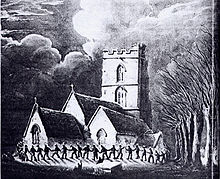- Clipping the church
-
 Clipping the church at Church of St Lawrence, Rode. Painting by W. W. Wheatley in 1848
Clipping the church at Church of St Lawrence, Rode. Painting by W. W. Wheatley in 1848
Clipping the church is an ancient custom that is traditionally held on Easter Monday or Shrove Tuesday in the United Kingdom. The word "clipping" is Anglo-Saxon in origin, and is derived from the word "clyp-pan", meaning "embrace" or "clasp".[1] Clipping the church involves either the church congregation or local children holding hands in an outward-facing ring around the church. Once the circle is completed onlookers will often cheer and sometimes hymns are sung. Often there is dancing. Following the ceremony a sermon is delivered in the church and there are sometimes refreshments.[2] Currently, there are only a few churches left in England that hold this ceremony.[3]
History
Little is known about the history of clipping, though it is said to have originated as a Pagan custom. It is thought to have been revived in the 19th century, when the earliest known mention of it was described in The Every-day Book (Hone, 1825); "L.S." describes the ceremony as a memory of his childhood.[4] It was a custom in several parishes in the Midlands, having died out in various places in the 19th century, but was performed widely across the country, from Yorkshire to Wiltshire and Derbyshire, as well as Birmingham, Somerset and Shropshire.[5][6] It was revived at St. Peter's Church, Edgmond, Shropshire in 1867, and continues there to the present day.[7] St. Mary's Church in Painswick is one of only a few other churches that perform this custom, on a Shrove Tuesday, and today it is performed by children.[3] Other churches that hold similar ceremonies include Burbage Parish Church, St Mary's Church, Wirksworth, and Guiseley Parish Church.[8][9]
At St Peter’s Church in Tankersley, Barnsley in the diocese of Sheffield the service of Cyppings is held annually on the second Sunday following St Peter’s day (29th June). Yeclepping is an ancient term meaning ‘embracing’. It is thought to have originated from pagan times but Christians quite wisely have adopted this tradition to show their love for their church and the surrounding people There are not many parishes that honour this ancient custom and all of them appear to honour it on a different day. It would appear that that some parishes observe this tradition on around the time of their Patronal festival and at St Peter’s; in Tankersley the Rector revived the tradition. The feast is celebrated on the 2nd Sunday following St Peter’s day (29th June). The reason for this is not far to seek. When the new ‘Kalendar’ was changed, by omitting 11 days, the good people of Tankersley neglected (or did they refuse) to change the time honoured day of their festival. Another important fact was that in the year of 1800, it was not considered a leap year and this interjected another day At Tankersley, there is a service held in the parish church followed by the congregation trouping out to form a ring around the church, They sing a Hymn played by a Trumpeter and in the case of St Peters’ of Tankersley it is the hymn ‘We Love thy place o God’. A prayer is then said with the congregation facing the church and then the congregation all face outwards to the world where they pray for the wider community and the world. Tankersley Church is built on foundations of an earlier place of worship which goes back to Saxon times. (indeed the battle of Tankersley Moor (in Oliver Cromwell’s days) was fought in this area and Cannon ball from this battle on show in the church. There is also a mention of a |Rector of Tankersley in the Domesday Book.[citation needed]
At the Church of St Lawrence at Rode, Somerset the circle face inwards dancing left and right before rushing towards the church with a cheer.[10]
References
- ^ Goddard, E. H. (1859). The Wiltshire Archaeological and Natural History Magazine. Wiltshire Archaeological and Natural History Society. pp. 244.
- ^ Journal. Colorado Education Association. 1846. p. 149–150.
- ^ a b Sullivan, Danny (2005). Ley Lines: The Greatest Landscape Mystery. Green Magic. pp. 166. ISBN 0954296346.
- ^ Hone, William (1826-27). The Every-day Book. London: T. Tegg. p. 431.
- ^ Tyack, George S. (2004). Lore and Legend of the English Church 1899. Kessinger Publishing. p. 71. ISBN 1417977078.
- ^ Allcroft, A. Hadrian (2003). Circle and the Cross. Kessinger Publishing. pp. 340. ISBN 0766176207.
- ^ Raven, Michael (2005). A Guide to Shropshire. Michael Raven. p. 76. ISBN 0906114349.
- ^ "Church Clipping, Wirksworth Church Clipping, Peak District Church Clipping, Wirksworth Customs, Peak District Customs". peakdistrictonline. http://www.peakdistrictonline.co.uk/content.php?categoryId=1798. Retrieved 2008-10-07.
- ^ "Church Information". Guiseley Parish. http://www.guiseleyparish.org.uk/churches.htm. Retrieved 2008-10-07.
- ^ "Clypping the Church". Rode History. http://www.avpu52.dsl.pipex.com/Clypping%20the%20Church.html. Retrieved 5 November 2011.
Categories:- Easter traditions
Wikimedia Foundation. 2010.
